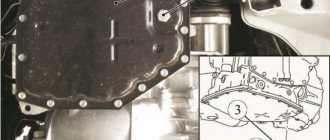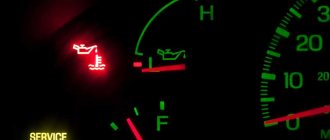How much does it cost to change oil and filters?
Engine oil change prices
| Name of service | Price |
| Changing engine oil with materials from an oil with removing the plastic engine protection | 14 rub. |
| Changing engine oil with materials from an oil with removing the iron engine protection | 16 rub. |
| Changing engine oil with customer materials | 18 rub. |
How long does it take to change engine oil?
It is difficult to overestimate the value of motor oil. Thanks to this, the engine is able to operate normally for a long period of time. It is known that lubricating fluid must be changed regularly. Perform this procedure after a specific startup. What is the change
engine oil and through
How many
kilometers, let's see here.
What happens to the oil during operation?
Motor oil is contaminated with fuel, dust and other debris, which includes liquid combustion products. In addition, oxidation occurs as a result of a chemical reaction and condensation may form in the oil. As a result, it becomes more aggressive towards engine components.
After some time, the oil thickens significantly and loses its useful cleaning properties, since during regular operation the additives introduced into the engine oil dissolve waste from fuel combustion if it is washed off in the form of soap. There is nothing to wash inside the engine; soot is deposited on it. Question: how long does it take to change engine oil? Five thousand kilometers, ten, twenty or thirty?
There is no exact universal gap because many factors influence its significance. This is immediately guided by the recommendations in the vehicle's owner's manual. However, in addition to them, there are other indicators. Having studied them, you can more accurately predict the required intervals after How many
replace engine oil.
Engine Operation and Design
Different engines are characterized by operating modes. Budget options don't stand up to heavy driving. If such a car constantly compresses everything we can, the oil will be consumed much faster, for this reason wear will increase and waste will be much simpler. More powerful diesel cars operate under high loads. Part wear is high. Therefore, diesel engine oil must contain a lot of additives. But, no matter what, the burnt liquid will be washed away by its own additives and will quickly become unusable. This must be understood and taken into account when replacing your engine with engine oil.
Replacement usually ranges from one to many times thousands of kilometers. If the trip is still active, then two, three thousand less.
city highway
Interestingly, when the car is primarily used in the city, the oil needs to be changed more often than when traveling on the highway.
This is due to the fact that you can safely drive on the highway without stopping at a certain speed. Along with this, traffic lights are constantly on in the city, causing traffic jams where you have to stand with the engine running. Therefore, in such conditions, it would be more correct to count hours rather than mileage. After all, you can drive a hundred kilometers along a route in an hour, even if it's twenty kilometers to the desired location, leaving our client eight hours.
How long does it take to change engine oil?
It turns out that in the suburbs the engine operates in a more gentle mode, so oil for diesel engines, in other words, gasoline, will be suitable longer. Unfortunately, when you constantly have to accelerate, you brake, this greatly affects gasoline consumption and lubricant service life. At the same time, many hours of idle time in traffic jams are not taken into account by the manufacturer.
cargo
The car has the ability to travel both in quiet mode and in luggage, with nettles and a trailer. Additional load is also acquired when driving uphill. The configuration is affected by engine oil. At higher loads, the oil must be changed more often.
Load level affects fuel consumption. Therefore, many experts believe that the lubricant should be replaced when connected to used gasoline. That's right, you get ten liters of fuel per hundred kilometers. Therefore, with the mileage required to change the oil for ten thousand kilometers, a thousand liters of gasoline will be required. From this, of course, we will recalculate how much
replace engine oil. That is, when a thousand liters of gasoline are consumed, it is replaced. After all, the mileage will be the same only when the car is running and gasoline is consumed. And the latter always come out not only because of downtime in traffic jams, traffic lights and other stops while the engine is running.
How much does an oil change cost approximately?
Oil change cost
may vary depending on the region, city and list of works from 400 to 2,500 rubles. In addition, even in the same locality, but in different car services, prices are different.
Interesting materials:
How can I connect an affiliate program on YouTube? How can I connect PS3 to a monitor? How can I connect sound from my computer to my TV? How to connect unlimited social networks on Beeline? How to connect wireless headphones on a MacBook? How to connect Wi-Fi on a MacBook? How to enable parental controls on mts? How to connect unlimited to Ukraine on play? How to limit the number of connections on a wifi router? How to find network connections on a computer?
Changing the oil and filter Freelander 2 with diesel engine 2
When accepting a Freelander car for repair, you can often hear a question from a client: “How long will it take to repair my car?” At first glance, the question is simple and understandable, there are manufacturer’s standards for performing operations, there is a mechanic’s experience, but often there is no exact answer.
Everything went according to plan until the turn came to removing the engine oil filter. The filter is not located in the most convenient place, namely on the front part of the internal combustion engine and is directed towards the cooling radiators. Access to it is only from the bottom of the car; using a 27 mm wrench you need to unscrew the plastic filter housing. And then it turns out that the key is not fixed on the filter housing, but rotates, not allowing even the opportunity to “tear” it off for further removal. The mileage on the car was approximately 280,000 km, therefore, over the entire service life of the car, the filter was unscrewed and tightened about 20 times, which did not affect the condition of the housing for the better - it lost strength and was deformed at the location where the key was installed.
How to change the oil and filter in the engine of a VAZ-2115 car
- place the car on a flat horizontal surface;
- after the engine has been turned off, at least five minutes must pass for the oil to completely drain into the oil pan and measurements can begin;
- remove the oil dipstick and wipe it dry;
- insert the device all the way into the crankcase;
- remove the dipstick and look at the marks on it. The fluid level should not be at or below the minimum level mark. If you find that this is the case, or the warning light comes on, you should immediately add lubricant to avoid engine failure.
It is recommended to use the same motor oil, but in case of replacement, it will be necessary to flush the engine with the same product that you decide to fill in later or with a special flushing composition. To replace the lubricant and oil filter, you will need the following tools and materials:
What affects the replacement frequency
Each car manufacturer provides detailed information in the car manual about when to change the engine oil. However, the fact is that this information is not always correct. As a rule, the documentation contains a value of 10...15 thousand kilometers (in each individual case the number may differ). But in reality, several factors influence the mileage between replacements.
10 indicators that affect the timing of engine oil changes
- Type of fuel (gas, gasoline, diesel) and its quality
- Engine capacity
- Brand of previously filled oil (synthetic, Semy-Synt, mineral oil)
- Classification and type of oils used (API and longlife system)
- Engine oil condition
- Replacement method
- Total engine mileage
- Technical condition of the car
- Operating conditions and modes
- Quality of consumables
The manufacturer's instructions are not included in this list, since for him the service interval is a marketing concept.
Operating modes
First of all, the timing of engine oil changes is affected by the operation of the vehicle . Without delving into the essence of the various transient processes, it is worth mentioning two main modes - on the highway and in the city. The fact is that when a car drives along the highway, firstly, the mileage accumulates much faster, and secondly, normal cooling of the engine occurs. Accordingly, the load on the engine and the oil used in it is not so high. On the contrary, if the car is used in the city, then its mileage will be significantly lower, and the load on the engine will be higher due to the fact that it often stops at traffic lights and traffic jams with the engine running. The cooling will be insufficient.
In this regard, it would be more intelligent to calculate how long it takes to change the engine oil, based on engine hours , as is done in truck, agricultural and water equipment. Let's give an example. The car will travel 10 thousand kilometers in urban conditions (at an average speed of 20...25 km/h) in 400...500 hours. And the same 10 thousand on the highway at a speed of 100 km/h - in only 100 engine hours. Moreover, the operating conditions of the engine and oil on the highway are much milder.
Driving in a metropolitan area is rightly equated to driving on rough off-road conditions in terms of how it destroys oil. This is especially true when its level in the crankcase is below average, and even worse when it is less than the minimum level. Also remember that in hot summer weather the oil is subject to a much greater load due to high temperatures, including from the hot surface of roads in big cities.
Engine size and type
What affects the frequency of oil changes
The more powerful the engine, the easier it is for it to survive load changes, as well as difficult operating conditions. Accordingly, the oil will not have such a strong impact. For a powerful engine, driving along the highway at a speed of 100...130 km/h does not place a significant load; it will be below average. As the speed increases, the load on the engine, and therefore on the oil, will change smoothly.
Small cars are another matter. As a rule, they are equipped with a “short” transmission, that is, the gears are designed for a small speed range and operating speed range. Accordingly, small engines experience greater loads in critical conditions than powerful ones. When the load on the engine increases, the temperature of its pistons also increases, and the amount of crankcase gases also increases. This leads to a general increase in temperature, including oil temperature.
It’s especially hard for small-displacement forced engines (for example, 1.2 TSI and others). In this case, the load is also supplemented by a turbine.
Additional factors
This includes high temperature control (operating temperature), poor ventilation of the engine crankcase (especially when driving in urban conditions), the use of low-quality or unsuitable oil for a given engine, the presence of dirt in the oil channels, a clogged oil filter, and the operating temperature range of the oil.
It is believed that the optimal engine oil change interval is from 200 to 400 operating hours under various operating conditions, with the exception of maximum load, including driving at maximum speed and maximum rpm.
The type of oil used is also of great importance - mineral, semi-synthetic or fully synthetic. You can read about each of the mentioned types separately using the links provided.
Fuel quality
It turns out that even the quality of the fuel being poured has a direct impact on the timing of engine lubricant replacement. The sulfur content of gasoline plays a decisive role here.
With a value of more than 50 ppm, such gasoline is not recommended for use in ordinary passenger cars. When fuel burns, sulfur is converted into sulfuric acid, which enters the fuel and oxidizes the engine oil. The grease becomes like tar.
Now let's move on to existing types of engine oils.
Changing engine oil: Costs, replacement interval and types of engine oils
Today, the algorithm of many drivers is simple. An icon pops up on the dashboard, which means it’s time to visit a car service center. Fortunately, not all car enthusiasts have yet lost interest in their cars. For those who care, we offer the ever-exciting topic about motor oil, about which, it would seem, everything that can be said has been said. Yes it is. But we decided to tell you in our own way about how often you need to change your engine oil, what oils to use, and how much a scheduled oil change usually costs.
Also equally important is the cooling function of engine oil. The fact is that motor oil absorbs heat from very hot engine parts. In addition, the oil washes away dirt particles from the internal components of the engine that are formed during the combustion process. Motor oil also absorbs the finest metal particles that are formed due to natural wear and tear of the internal components of the power unit.
27 Jun 2022 stopurist 615
Share this post
- Related Posts
- Who issues a certificate of state registration of rights
- Deadlines for notification of termination of a fixed-term employment contract
- Guvd Chelyabinsk Region Vouchers to Sanatoriums for the 2nd Quarter of 2020
- Tax Deductions for the Purchase of a Used Car
Features of car operation
Operating conditions are not only about vehicle mileage. This includes the following features:
Operating mode . Driving in the city and on the highway are two big differences. If you often drive in a big city (read: in traffic jams), often starting and braking, the engine fluid becomes very hot. And with constant strong heating, the lubricant loses its beneficial properties.
And at idle speed of the car there is practically no oil circulation in the engine. If you follow the manufacturer's recommendations and change the oil every 15 thousand km, you need to understand the following: in the city this mileage can last more than 500 hours, and on the highway - 250, if not less. Can you imagine what could happen to the engine and engine lubricant if you change it strictly according to the regulations during city driving?
Driving in traffic jams is a difficult test for the engine
When driving on the highway at an average speed of 120 km/h, the load on the engine is light, oil circulation is optimal, and it ages much more slowly compared to the city cycle. Engine cooling during country driving is also much better than during city driving.
The quality of the oil during city driving deteriorates 3-4 times faster than on the highway with the same mileage.
A difficult test for an internal combustion engine is driving in the city for short distances. The oil simply does not have time to heat up to the required temperature, and the amount of additives in it decreases. Oil ages much faster.
Speed . Frequent driving at high speeds constantly loads the engine. The oil oxidizes much faster than expected and becomes dark and thick. And the thicker the lubricant, the higher the load on the engine, especially if it is not powerful. All this leads to rapid failure of the internal combustion engine. The same applies when traveling off-road, on frequent descents and ascents.
Climate . When operating the machine in extreme temperature conditions (extreme heat, humidity or cold), you will have to change all consumables, including oil, more often.
Ideal operating mode for oil and engine:
- ½ of the maximum driving speed;
- minimum idle time after warming up the engine.
I'll explain it even simpler. There are the following types of car enthusiasts:
- Car for a summer residence . Mileage per year is a couple of thousand km. How often do you change the engine oil if the car is stationary? Change your oil every year, even if your mileage has increased only slightly.
- Car for the weekend . Trips only on weekends outside the city. Mileage per year – 15 thousand km. The conditions here are also almost ideal. Feel free to change it when the mileage reaches 12-15 thousand km.
- Car for work . Driving daily in the city and traffic jams. The average speed here is very low, the mileage per day is 20-30 km, a person spends many hours in the car. During the same time, when driving on the highway, it was possible to cover several times more kilometers. Therefore, it is better to count engine hours rather than mileage here. I wrote above how to count them. This way you will extend the life of the motor as long as possible. You can, of course, count the amount of fuel spent. For example, dash off 1000 liters of fuel and change the oil. But this is not entirely accurate due to different volumes and types of engines.
Driving on the highway at medium speed is ideal for the engine and engine, compared to city driving
Note! If you still act strictly according to the instructions of the car manufacturer and slightly delay the replacement of engine oil (by 15%), then nothing bad will happen. If this period is increased to 5 thousand km or more, then get ready to repair the engine.
Remember! The officially recommended engine oil change interval is not correct or optimal for any vehicle.
Engine size and type
The more horsepower an engine has, the easier it is for it to cope with the load, so the oil in it ages more slowly. For example, at a speed of 130 km/h on the highway, there is very little load on the powerful engine. And a weak engine, especially if it is forced, heats up more and wears out. Therefore, in cars with weak engines, the oil should be changed more often (no more than 7-10 thousand kilometers between intervals).
In a powerful engine, oil ages more slowly
As for vehicles for transporting goods and passengers, the oil change interval can reach 20-40 thousand km. You can also try these high-quality oils for your car, which will improve the performance of your engine.
In forced turbocharged internal combustion engines, or in conventional ones that are used extremely, it is recommended to change the lubricant after 5 thousand kilometers. During the procedure itself, you must completely remove the old oil from the engine.
What are the features of changing oil in diesel engines with a turbine? It must be changed a couple of thousand kilometers earlier compared to gasoline engines due to the high presence of sulfur in diesel fuel.
Recommendations for changing engine oil
Next, we will dwell in more detail on the question of how often to change the engine oil. As stated above, car manufacturers' recommendations should be taken with a grain of salt. Don't completely ignore them, but make your own amendments . If you drive your car only in city conditions (statistically, this is the majority of car owners), this means that the oil is used under heavy duty conditions. Remember that the less oil in the crankcase, the faster it ages. Therefore, its optimal level is slightly below the maximum mark on the indicator dipstick.
After how many thousand do you change the engine oil?
Calculation of engine hours for oil changes
We wrote above that it is better to calculate the frequency of oil changes based on engine hours. However, the complexity of this technique lies in the fact that sometimes it is difficult to convert kilometers into engine hours and get an answer based on this information. Let's take a closer look at two methods that allow us to empirically , but quite accurately, calculate how often to change synthetic (and not only) engine oil. To do this, your car must have an ECU that shows the average speed and fuel consumption over the last at least one thousand kilometers (the longer the mileage, the more accurate the calculations will be).
So, method one (calculation by speed). To do this, you need to know the average speed of your car over the last few thousand kilometers and the car manufacturer's recommendations at what mileage you need to change the oil. For example, the mileage before an oil change is 15 thousand kilometers, and the average speed in the city is 29.5 km/h.
Accordingly, to calculate the number of engine hours, you need to divide the distance by the speed. In our case it will be 15000 / 29.5 = 508 engine hours. That is, it turns out that in order to change the oil under these conditions, it is necessary to use a composition with a service life of 508 engine hours. However, in reality, such oils simply do not exist today.
We offer you a table showing the types of motor oils and their corresponding engine hour values according to API (American Petroleum Institute):
| Table of correspondence between oils and service life hours | |
| Oil type | Resource number of engine hours |
| Mineral | 150 |
| Semi-synthetic | 250 |
| Synthetic oils | |
| API SJ/SL | 250 |
| API SM/SN | 300…350 |
| Polyalphaolefins | 350…400 |
| Esthers | 400…450 |
Let's assume that the car engine is filled with SM/SN class oil, which has a working life of 350 hours. To calculate the mileage, you need to multiply 350 engine hours by the average speed of 29.5 km/h. As a result, we get 10325 km. As you can see, this mileage is very different from what the automaker offers us. And if the average speed is 21.5 km/h (which is more typical for large cities, taking into account traffic jams and downtime), then with the same 350 engine hours we will get 7525 km of mileage! Now it becomes clearly clear why it is necessary to divide the mileage recommended by the car manufacturer by 1.5...2 times .
Another calculation method is based on the amount of fuel consumed. As initial data, you need to know how much fuel your car consumes per 100 km according to its passport, as well as this actual value. It can be taken from the same ECU. Let’s assume that according to the passport the car “takes” 8 l/100 km, but in fact – 10.6 l/100 km. The mileage for replacement remains the same - 15,000 km. Let's derive the proportion and find out how much theoretically spend to cover 15,000 km: 15,000 km * 8 liters / 100 km = 1200 liters. Now let's make similar calculations for actual data: 15000 * 10.6 / 100 = 1590 liters.
Now we need to calculate at what distance the actual oil change (that is, how long the car will travel on a theoretical 1200 liters of fuel). Let's use a similar proportion: 1200 liters * 15000 km / 1590 liters = 11320 km.
We present for you an electronic calculator that will allow you to calculate the actual mileage before an oil change using the following data: theoretical fuel consumption per 100 km, actual fuel consumption per 100 km, theoretical distance to an oil change in kilometers:
However, the simplest and most effective method of checking is a visual inspection of the condition of the oil. To do this, do not be lazy to periodically open the hood and check whether the oil has thickened or burned. Its condition can be assessed visually. If you see that oil is dripping from the dipstick like water, then this is a sure sign that the oil needs to be changed. Another interesting method of checking is by spreading the composition over a napkin. Very thin oil will form a large and runny stain, which will tell you that it is time to change the fluid. If this is the case, immediately go to a car service center or carry out the procedure yourself.











